Table of Contents: Intro & 1920; 1921-1923; 1924-1927; 1928-1932; 1933-1935; 1936-1939; 1940-1945; 1946-1949; 1950-1953; 1954-1956; 1957-1959; 1960-1963; 1964-1966; 1967-1969; 1970-1973; 1974-1976; 1977-1979; 1980-1983; 1984-1986; 1987-1989; 1990-1993; 1994-1996; 1997-1999; 2000-2003; 2004-2006; 2007-2009; 2010; 2011; 2012; 2013; 2014; 2015; 2016; 2017; 2018; 2019; Recap & 2020; 2021; 2022
Just a reminder that we’re still running our Crowdfunding campaign to support Buggy100 on April 16-18, 2020. If you haven’t donated already (or even if you have), please consider giving to the Crowdfunding so that we can make Buggy100 the event that it deserves to be. Click here to view the Buggy100 Crowdfunding page.
This week, the 100 Years of Buggy History Series focuses on the mid-1980s. Buggy explodes (figuratively), as upwards of 50 teams enter the races on the Men’s side. Buggy endures friction (literally and figuratively), as controversial decisions affect results and paved roads produce new winners. And Buggy catches fire (literally), as a truck fire changes the rules forever.
1984
Raceday: Prelims on Friday, April 13 at 8:00am; Finals on Saturday, April 14 at 7:30am
Sweepstakes Committee: Nancy Burns (Chair); Luan Denny (Ass. Chair); Mark Licata (Safety); Becky Sikora (Design); Perry Kirk, Rod Golden (Buggy Book)
Men’s Results: (1) PiKA A – Mach I (2:09.50); (2) SigNu A – Lemur (2:09.96); (3) Beta A – Vixen (2:15.01); (4) CIA A – Black Magic (2.15.95); (5) PiKA B – Godzilla (2:17.43); (6) Beta B – Athena (2:18.00)
Women’s Results: (1) PiKA A (Theta) – Bullet (2:48.6); (2) CIA A – Black Magic (2:49.0); (3) Fringe A – Benefit (2:52)
Design Comp: (1) Theta Xi – Rapier
Weather: Cloudy (with early AM rain), 50-62 Degrees on Friday; Rain early, then variable clouds and sun, 48-62 Degrees on Saturday
Buggy Book: 1984 Buggy Book Link
Prediction Score: 29/45 Men’s; 0/10 Women’s (Compubookie); 34/40 Men’s (Buggy Chair Consensus)
As the battle between fraternities and independents raged on, the combination of pusher defections and excellent new drivers helped propel PiKA to a clean sweep of Buggy in 1984.
- ZBT Races For the Final Time. For the second year in a row, a fraternity was suspended by CMU, ending their Buggy year. ATO made their return after being suspended for the 1982-1983 school year, but for 1983-1984 ZBT was the one feeling the wrath. The suspension appears to have resulted from a Fall rush party gone bad, where the fraternity served mixed drinks and Jack Daniels. People under 18 had reportedly attended the party, and 3 freshman ended up in the hospital for alcohol poisoning. Dean Walter, who played a role in the suspension, stated that “the potential loss of life was serious”, and as a result ZBT was suspended and prohibited from participating in activities for the year, which included Buggy. They were also placed on probation for the 1984-1985 school year, and because of that, 1983 would be the last time that this iteration of ZBT participated in Buggy. While on probation on October 2, 1984, brothers of ZBT engaged in a brawl with members of the Korean Student Association, and as a result ZBT was kicked off of CMU’s campus for good. The brawl sent four students to the hospital and involved the use of nunchuks. As a note, a new chapter of ZBT would eventually be colonized in 2006 and make their way out to the Buggy course in 2010, but it would be a short-lived version of the fraternity that is no longer active.
- The Battle Over Funding For Independents. There has long been a debate in Buggy over the funding advantages and disadvantages that the different organizations have. In 1984, this debate became a bigger part of the story for Fringe. According to the November 1, 1983 Tartan, in Fringe’s 14 year history they had been self-supporting; buggy chairs Scott Durbin and Pete Comey both dipping into their personal savings to fund the buggy team in 1983. But for 1984, Fringe wanted to alleviate some of this financial burden, so they requested $445 in funding from Student Senate for the 1983-1984 year. However, this request created backlash, as some of the other buggy teams felt that Fringe would be receiving an unfair advantage by receiving student activities funds that fraternities were not eligible for. Fringe eventually withdrew the funding request, reasoning that Student Senate required an in depth accounting of expenditures and Fringe might struggle to fulfill that, since say get supplies “any way we can. It is difficult to get a receipt for everything.” Although Fringe withdrew the request for the 1983-1984 school year, the debate over Student Senate funding would become a big topic during the 1980s, and we’ll be touching more on this issue coming up.
- Buggy Events. 4 Fall rolls were scheduled as practice for Raceday 1984. These were all on Sundays, and were scheduled for October 16 and 30 and November 6 and 13. In addition, the first “History of Buggy”-style exhibit launched during Spring Carnival 1984. It was entitled “Buggy Evolution: 4:38-2:09”, and it was an exhibit in Hunt Library that was made available all Carnival weekend (we plan to improve on this for Buggy100 this year).
- Predictions. The copycats sparked by the success of Lemur in 1982 even got Compubookie’s attention in 1984. Compubookie wrote: “How many Lemurs will there be this year? In all my years I’ve never seen so many new buggies. All of the top finishing organizations of last year have new three-wheelers.” Compubookie noted that Theta Xi and PhiKap looked promising this year, and that Beta, SigNu, CIA and PiKA were expected to be their usual top selves. Compubookie went on to predict a top 6 in Men’s: (1) PiKA A, (2) Beta A, (3) SigNu A, (4) CIA A, (5) Theta Xi A, and (6) PiKA B, with the winning time being a 2:09.5. He also predicted that CIA A would win the Women’s races and that PiKA would win the Alumni races, and that the most exciting heat would be Men’s Prelims Heat 14 (Theta Xi A vs. Beta A vs. SDC A). Meanwhile, the Tartan also spoke with the buggy chairs from the various organizations, and I have again compiled their picks for the Men’s races into a consensus based on a 5-3-1 scoring system. The buggy chairs simply provided the orgs that they thought would win, not the specific team/letter, but the consensus prediction was: (1) PiKA, (2) SigNu, (3) Beta, (4) CIA, and (5) Theta Xi.
- PiKA’s Driver Advantage. The Spring Carnival edition of the 1984 Tartan referred to Sweepstakes 1984 as the “Year of the Driver”. And the top driver in the game that year was Audrey Greenfield. A freshman for Raceday 1984, the Tartan noted that with her 4 years of eligibility and “extremely narrow body”, PiKA decided to build a new buggy specifically to fit Greenfield’s measurements. That buggy became the very small, and very fast, Mach I. And building on Godzilla from 1983, PiKA again utilized their dropping pushbar technology. Greenfield, combined with Men’s C/Women’s A driver Kim Ciulla and Men’s B driver Carol Evans, made up for the strongest buggy driver’s room in the field in 1984.
- New Buggies. Mach I wasn’t the only new buggy to debut in 1984. The fastest of the new buggies belonged to SigNu, who rolled out their new buggy, Colugo. A lighter and faster buggy than their previous builds, Colugo also presented some risk due to its wide wheel base. The crowd favorite among the new buggies was PiLam’s Miss Budweiser, which was never competitive for a trophy but made for some exciting battles with its archrival, SAE’s Limo (as discussed below). Theta Xi produced both Rapier, a top Design Competition contender, and Little Nip, a top racing contender. Fringe also created a solid Design Competition buggy and started to reveal a theme to their names with the new buggy Benefit. PhiKap introduced a new buggy named Silhouette, and Beta introduced their short-lived buggy Athena. DU brought out a buggy named Flying Tiger, and CIA created their new buggy, Spectre. And lastly, the Tartan suggested that SAE would be rolling out a new buggy named IQT, but the SAE D team was scratched and no buggy named IQT ever appeared on the course, so we don’t know what this buggy was or if it was actually built.
- Rain Impacts Saturday. The weather held up on Friday, but Saturday wasn’t quite as easy. Early morning rains that ended at 6:30am led to a 90 minute delay before the Women’s races, as Sweepstakes waited for the roads to dry. After the women’s races, thunderstorms loomed over the Men’s Finals. Luckily, the rains held off until the races were over, and the sun even managed to poke its head out of the clouds briefly, allowing Sweepstakes to get 2 full days of racing in.
- Championship Defection. CIA had won the previous two Women’s races, and came into 1984 as a heavy favorite for their third straight title. But what the prognosticators missed was one of the biggest defections in Buggy history. Debbie Kovacs, who had led the CIA Women’s push team to those previous 2 victories, was a member of Kappa Alpha Theta. In 1984, PiKA decided they weren’t content with just winning the Men’s and alumni races, so they teamed up with Kappa Alpha Theta to field a Women’s team pushed by the sisters of Theta. As a result, Debbie Kovacs left her CIA team to push for PiKA A. PiKA A, using the Men’s C team buggy Bullet, was the first of the two to hit the course, running in Heat 4 out of Lane 1. Led by Debbie Kovacs and Hill 2 pusher Beth Marcus, PiKA A/Theta surprised everyone, easily winning the heat and clocking in at 2:48.6. CIA A went next, in the 5th and final heat. And it was there that the loss of Debbie Kovacs was felt the most, as the team had no problem beating SDC A and SigNu A in the heat, but stopped the clock at 2:49.0, losing the trophy to PiKA by 0.4 seconds (very likely the difference between Debbie Kovacs and the alternative pusher from each team). Meanwhile, the 3rd place time came from Women’s Heat 3, where Fringe A’s Benefit clocked it at a somewhat surprising 2:52 time and was the only buggy to finish the race, as both DU A and KapSig B ended up as a DNF. The times for the Women’s races that we have are below:
- PiKA A (Bullet) – 2:48.6
- CIA A (Black Magic) – 2:49.0
- Fringe A (Benefit) – 2:52
- SDC A – 3:00.5
- CIA B (Spectre) – 3:01.6
- Beta A/TriDelt (Echo) – 3:08
- PiLam A (Legend) – 3:08.8
- Theta Xi B – 3:21
- Unknown Times: SDC B, KapSig A, PiLam B, Theta Xi A, SigNu A
- DNF: DU A, KapSig B
- Alumni
Races. We don’t have any juicy details
about the alumni races themselves, but we do have the results. PiKA was widely expected to take the alumni
heats as well, as they were seen as the only team that cared about the alumni
races. And sure enough, those
predictions panned out. The Top 6 (with
estimated times, as the decimals were cut off in the scan that we had) were:- PiKA (Bullet) – 2:21
- Beta (Echo) – 2:32
- PiLam (Legend) – 2:37
- KapSig – 2:42
- DTD (Cyclone) – 2:45
- CIA (Black Magic) – 2:46
- Men’s Prelims. The mid-1980s saw the peak number of Buggy teams, and the field expanded again in 1984, with a then-record 49 Men’s teams (from 14 organizations) and 15 Women’s teams (from 10 organizations) entering the races, though not all of them actually reached the starting line.
- Battle of the Basement. 1984 began a whole new rivalry, but this one wasn’t for a trophy. For the past few years, Sweepstakes had put some of the non-competitive D teams up against each other in Prelims Heat 1 to get Raceday started, and they did it again in 1984, with SigNu D’s ESP, Beta D’s Echo, and Theta Xi D’s Relayer. But the real battle came in Prelims Heat 2. That heat pitted the worst of the worst against each other – it was PiLam C’s new buggy, Miss Budweiser, in Lane 2, with SAE C’s champion slowpoke, Limo, coming out of Lane 1 (KapSig D was listed on the Heat Schedule as well, but we don’t have any information that they rolled). And they kicked off one of the greatest rivalries in Buggy history in style – literally. SAE’s pushers decided to push Limo in tuxedo jackets and dress tops – the perfect companion to their white athletic shorts. Sure enough, the formalwear helped SAE “win” by putting up the slower time, as PiLam’s Miss Budweiser was more than 20 seconds faster than SAE, though from the video (see below), it appears that the PiLam C Hill 5 pusher may not have had the pushbar as the buggy crossed the Finish Line.
- Pushers Beware. 1984 wasn’t the year to be a Men’s pusher. Prelims Heat 3 became a 2 team affair after SAE D scratched. This left PhiKap D in Lane 3 and Beta C in Lane 2. Beta was the first one up the hill and the first to finish the race, but it didn’t end up mattering. At one point during the race, Beta pusher Ron Orie stepped on the PhiKap D buggy. This was deemed to be interference, and Beta C was DQ’d. But Ron wasn’t the only pusher who had a rough day. In Prelims Heat 7 (labeled Heat 8 in the Buggy Book), ATO A’s Gander went up against KapSig C and CIA D. ATO A won the heat (though CIA D wasn’t far behind). But KapSig C ran into trouble on Hill 4; that trouble was ATO pusher Mariso Taverna. KapSig was granted a reroll, which would suggest that ATO was DQ’d for interference, but we have no record of ATO A being DQ’d (their time was well outside the top 10 anyway).
- Unlucky #6. Prelims Heat 6 (labeled as Heat 7 in the Buggy Book) was a heat of both highs and lows. Beta B’s new buggy Athena was the highlight of the heat, and they put together a strong performance coming out of Lane 3. Beta B stopped the clock at 2:15.97, the 4th fastest time of the day, with Hill 5 pusher Brad Sherwin running the fastest Hill 5 of the day. The other two teams didn’t fare as well. SAE A clocked in at 2:23.44, but was DQ’d for an unknown reason. And SigNu C’s Scorpion, which finished in 2:38.15, failed drops and was also DQ’d.
- Double Trouble. The most excitement from a non-time perspective came from Prelims Heat 11 (listed as Heat 12 in the Buggy Book). This heat saw the debut of SigNu B’s Colugo in Lane 1 going up against KapSig A and PhiKap C. PhiKap C finished the race without incident, but the same could not be said of the other two. The trouble came with the lead buggy, SigNu’s Colugo. At some point during the freeroll (likely prior to the Chute), the driver’s headgear shifted and came down over her eyes, affecting her vision. The result was that she lost control of the buggy and spun out. KapSig was affected by this as well, though we don’t know if they braked or just lodged an objection. Either way, both SigNu and KapSig protested, asking for a reroll. Sweepstakes ultimately granted both reroll requests. In the reroll, which was run on Friday after the Prelims Heats, KapSig A and SigNu lined up together again, with the addition of KapSig C. And much like Prelims Heat 11, the other buggy, KapSig C, was the only one to finish. Reports said that SigNu’s Colugo was running “the fastest run ever in buggy history” (though, as a B team, we have some doubts about this). But as they reached the chute, the driver oversteered and the buggy spun out, ending up in the haybales. The driver was shaken up, but was otherwise ok. KapSig A, meanwhile, presumably hit the brakes, as they sputtered to a stop in the Chute, with the buggy being picked up and carried off, rather than finishing the race. And the good news is that you can see Colugo’s spin for yourself in the 1984 video below (around the 0:08 mark)!
- Men’s Finals. Most of the mid-race drama of the Finals came during Finals Heat 1, pitting PiKA B’s Godzilla, the 3rd fastest finisher on Friday, against Beta A’s Vixen, the 6th fastest. Beta A ran a little better on Saturday, and as a result, PiKA B was behind as they entered the Chute. Beta A went through first, but PiKA B was gaining as they turned into the Chute. PiKA’s driver Carol Evans was forced to swerve in order to avoid making contact with Beta. She began to skid and Godzilla’s nose ended up tapping the haybales, but she recovered out of the skid and managed to stay in the race. It was an impressive driving maneuver, and guess what? You can actually see it! We have the video below. PiKA B’s time was 3 seconds slower than Day 1, but impressive driving kept them in the top 5. Finals Heat 2 saw the winning roll from PiKA A’s Mach I, who was the 2nd fastest coming into the day, as they defeated CIA A’s Black Magic with a time of 2:09.5. Prior to Finals Heat 3, SigNu’s team got themselves psyched up with 5 minutes of dancing, clapping, and celebration in front of their truck. In the Heat, SigNu A’s Lemur had a 5 window rollout as it went up against Beta B’s Athena. SigNu easily won the heat, and as they crossed the finish line, the clock read 2:09. The crowd at the finish line was silent as they awaited the decimal points to go up on the scoreboard. When they did, some of the crowd erupted – the PiKA fans – as the final time read 2:09.96, less than 0.5 seconds behind PiKA A.
- They Call Him Flipper. The Spring Carnival edition of the Tartan included an article from Pauline Wen, a “veteran” of Spring Carnival. One thing she pointed out was that PhiKap “introduced a two-wheeled buggy”. She stated that the buggy was appropriately nicknamed “Flipper”. However, we don’t believe that PhiKap actually built a 2-wheeled buggy. Instead, it appears that PhiKap’s Silhouette, most likely their B team buggy, flipped over somewhere on the course. But this is all speculation until someone can confirm what happened. So if you were there, let us know! But whether PhiKap’s buggy ended up on two wheels or not, it may have given someone an idea, as the two-wheeled era was about to make a comeback the following year.
- 1984 Video. We’ve got the video from 1984, and it’s impressive. I’m not sure who shot this, but whoever did, thank you! This is a quality video of large portions of Men’s Finals Heats 1 and 2, including the broadcast commentary. It also has a montage of what appears to be Day 1 buggies, including some spins, missed pushbars, and even a dog attack!
1985
Raceday: Prelims on Friday, April 19 at 9:00am; Finals on Saturday, April 20 at 9:00am
Sweepstakes Committee: Luan Denny (Chair); Curt Abel (Ass. Chair); Mark Decker (Safety); Dean Kovalkovich, Barb Zagula (Design); Kevin McHugh, Gregory Morse (Buggy Book)
Men’s Results: (1) SigNu A – Colugo (2:10.09); (2) Beta A – Vixen (2:13.27); (3) Beta B – Nike (2:15.93); (4) CIA A – Black Magic (2.20.14); (5) PiKA A – Mach I (DNF); (6) PiKA B – Breathless (DQ)
Women’s Results: (1) CIA A – Black Magic (2:45.33 – COURSE RECORD); (2) Theta Xi A – Little Nip (2:48.92); (3) Fringe A – Benefit (2:51.48)
Design Comp: Unknown
Weather: Partly Cloudy with wind, 72-79 Degrees on Friday; Sunny, 71-80 Degrees on Saturday
Buggy Book: 1985 Buggy Book Link
Prediction Score: 27/45 Men’s (Compubookie); 19/40 (Buggy Chair Consensus)
1985 saw the introduction or re-introduction of several things to Buggy: Spirit, 2-wheelers, controversies, and SABOTAGE!
- Can You Feel The Spirit. SPIRIT House had been an active organization on CMU’s campus since the late 1960s. But in 1985, they decided to broaden their activities and added a Buggy team! Thanks to ZBT getting kicked off campus in the Fall of 1984, ZBT’s old buggy Pegasus was suddenly available for use (but see below). So Spirit decided to get in the game and obtained that buggy. The Spirit pushers were solid, but Pegasus itself wasn’t a top tier buggy, and as a new team, Spirit had never rolled on Raceday wheels and at Raceday speeds. According to Matt Wagner, going full speed caused Pegasus’s hatch to pop up early in the freeroll, acting as an air brake, causing the buggy to crawl through the freeroll. As a result, Spirit’s final time barely beat SAE’s Limo (and lost to PiLam’s Miss Budweiser). But it gave the organization the necessary foundation to quickly move up the ranks. It wouldn’t be long until Spirit became a Buggy powerhouse.
- Pegasus…or Prophecy? We mentioned about that Spirit obtained ZBT’s Pegasus in the Fall of 1984. But 38 years later, that’s come into a bit of question…because the buggy that Spirit rolled as Pegasus looks a lot like ZBT’s Prophecy, and not so much like ZBT’s Pegasus, all the way down to “the clunky homemade caliper style brakes on the rear wheels” (per Matt Wagner). According to Robert Bowie, the first Spirit Buggy Chair back in 1984, “ZBT had one serviceable buggy left and was willing to sell it for next to nothing. I thought the ZBT guy — Larry told me the name was Pegasus… he was only a sophomore and probably never participated in Sweepstakes. So…we bought the buggy and kept the name.” But it seems as though the ZBT member get the names of their buggies confused. Thus, ZBT’s Prophecy became Spirit’s Pegasus, while ZBT’s Pegasus was never to be seen on the course again…and we’re only discovering this in 2022.
- Fringe Funding Part 2. As noted previously, in 1984 Fringe attempted to secure $445 in funding from Student Senate before withdrawing the request. But they moved forward with their plan to acquire Student Senate funding for the 1984-1985 school year. The request was for $1,797, to cover both booth and buggy supplies, and at the end of the Spring 1984 semester, Fringe’s request was granted. However, the funding came with a couple of stipulations. First, Fringe was not eligible for funding for new tools (for booth or buggy) for a period of 5 years following the receipt of these funds. Second, Fringe was not permitted to build a new buggy for 3 years following the allocation of funds, after having built Benefit in 1984 (though it seems they waited only 2).
- New Timing System. The 1984 races, on both the Men’s and Women’s side, were particularly exciting, as less than 1 second separated the top 2 teams in each division. Because of that, Sweepstakes made one of their top priorities for 1985 the acquisition of a new timing system. The system was a video timing system. The good news was that it made the times more accurate. The bad news was that it took a long time to review the tape, so official times from Friday weren’t made available until Saturday morning. But the timing system was ultimately deemed a success, and returned for subsequent years.
- Roads Paved. We don’t know what part of the course was paved, but we do know that at least some part of the course was paved prior to Raceday 1985. But that wasn’t the only road condition that played a role in 1985.
- Another Attempted Course Sabotage. 1985 was the 50 year anniversary of the first attempted course sabotage, which we covered previously. So someone apparently got the idea to “celebrate” that anniversary by trying to sabotage the course again. The night before Raceday 1985, an unknown person or persons came out to the Buggy course and poured oil on the roads. This was a major safety hazard, and Sweepstakes was forced to delay Friday’s races for nearly 2 hours. From the photo in the Tartan, it appears that a fire truck was also required to help clean the road.
- The 2-Wheeler Returns. The bike era ended for good in the late 1970s. But with the top organizations all dropping from 4 wheels down to 3, DU had the idea to take things one step further. So they lost one more wheel and brought out the first 2-wheeled buggy to race in the decade. It’s something that DU had experience with before, rolling Captain America in the early 1970s, and their new buggy, the Horned Screamer, was a bit of a throwback to that old one. It was largely a shrouded bicycle that rolled on 2 wheels, but it included 2 small training wheels to provide stability on the hills. The buggy wasn’t the fastest, but it did give DU a bit of an edge over some of its competitors and would kick off the final 2-wheeled buggy era. The buggy made it successfully through the course for the first time in practice on Saturday, April 12, and completed the course again without falling on Raceday, clocking in 14th overall in the Men’s division in a 2:24.22.
- Carbon Fiber. In 1985, most buggies tended to be built with an aluminum frame, which was lighter than some of the earlier metals used to build buggies (such as steel) but still provided the necessary driver protections. But aluminum was still heavy, and teams had long since realized that the key to a successful buggy was to make it light. In 1985, SigNu came up with a new material to use to make a buggy lighter – carbon fiber. According to Mark Estes, SigNu built their new buggy for 1985, Yama Bachi, from carbon fiber pre-preg, which was vacuum bagged and cured in an oven that SigNu constructed. The buggy fully assembled weighed under 50 pounds, though there were some design issues with mounting the wheels that prevented Yama Bachi from achieving its maximum potential.
- Other New Buggies of 1985. DU and SigNu weren’t the only organizations producing new buggies in 1985. The top teams all continued their tradition of building a new buggy every year. PiKA produced Breathless, going back to the 4-wheel design but shifting to small wheels for the first time, with all four wheels enclosed within the shell and drag brakes. Beta constructed their new buggy, Nike. DTD brought out a new buggy named Crisis, and CIA debuted their new buggy, Interceptor. A photo in the 1985 Buggy Book suggests that DTD also built a buggy named Vatos, but the 1986 Buggy Book suggested that Vatos was built in 1986; either way, as far as we can tell, Vatos never raced. Lastly, PhiKap rolled out not one, but two new buggies, Gumby and King Kong Bundy.
- Predictions. Compubookie was both pretty spot on and pretty far off in his predictions for the Men’s races in 1985. This was likely because of the issues PiKA had (see below). Overall, he correctly guessed the Top 6 teams but whiffed badly on the order. Compubookie’s Men’s predictions were: (1) PiKA A; (2) Beta A; (3) SigNu A; (4) CIA A; (5-TIE) Beta B and PiKA B. The Buggy Chairs also made some mild Men’s predictions, and on a 5-3-1 scale, they went: (1) Beta; (2) PiKA; (3) SigNu; (4) CIA; (5) Fringe. The Tartan did not publish any Women’s predictions this year.
- Buggy Trumps Track Again. We’ve noted in previous years the impact that Buggy has had on the CMU track team. And in 1985, another battle arose, as the track team had a meet against Hiram College scheduled for Spring Carnival weekend. And Buggy once again won the battle. Joe Honse, the then-current CMU record-holding pole vaulter, elected to skip the meet in order to push buggy for PiKA. The good news was that the track team didn’t need him in that meet, as CMU easily defeated Hiram (another CMU student, Phil Gerard, ended up winning the pole vault). The bad news is that Joe’s buggy team didn’t fare as well.
- A Controversial Decision. The big non-sabotage story of 1985 came from the PiKA A Men’s team. With driver Audrey Greenfield in Mach I, PiKA A easily advanced to the Finals with the 2nd fastest time of the day (2:09.95), less than 1 second behind SigNu A’s Colugo. That put them in Finals Heat 2, where they went up against Beta B and Beta’s new buggy, Nike. But PiKA suffered their first problem of the heat pretty quickly. The pushbar on Mach I triggered too early and the latch released while being pushed up Hill 1, causing the pushbar to drop. This impacted the Hill 1 push, slowing PiKA down up the front hills. Beta B put together a pretty strong Hill 1 and 2, and the combination allowed Beta B to keep up with PiKA. The two buggies entered the freeroll neck-and-neck. But Beta B’s Nike was rolling slightly faster, and as a result, Paulette Hebert, in Beta’s Nike, prepared to pass Mach I. As they approached the Stop Sign, Paulette was fully ahead of Audrey in Mach I, and she began to move Nike over as they headed for the transition flag. This prompted Audrey to hit the brakes in Mach I, causing her to spin out. The Tartan reports that she hit a tree, though she was not seriously injured. Immediately after the race, PiKA filed a formal protest, arguing that the Beta buggy cut off Mach I and requesting a re-roll. The Tartan reports that from the lead truck, it was difficult to see who was at fault, though it appeared that Beta took a straight line on the outside lane. Just before the 3rd and final Heat, Head Judge Nancy Burns determined that no re-roll would be granted. However, after the final heat ended, she reversed her decision and granted PiKA’s reroll request. But by then it was too late, as the initial reports of no re-roll caused the barricaders to open the roads right after the 3rd Finals Heat. Sweepstakes attempted to clear and re-close the roads, but they were unable to do so successfully, and therefore PiKA A was left with the DNF.
- More PiKA Problems. PiKA A wasn’t the only PiKA Men’s team to have issues. PiKA B, with their new buggy Breathless, put up the 3rd fastest time on Friday and also advanced to the Finals. They were placed in Finals Heat 1 against CIA A’s Black Magic. The race itself wasn’t close, as CIA A lost 4.5 seconds on their way to a 2:20.14, whereas PiKA B only lost 2 seconds, clocking in at 2:13.30. But the new buggy didn’t necessarily have all the kinks worked out, as it failed its Drop Test (somewhat surprising, given that the buggy used drag brakes) and was DQ’d on Saturday, resulting in a 6th place finish.
- SigNu’s Championship. The beneficiary of the PiKA incidents in 1985 were their archrivals, SigNu. SigNu made the decision to run Colugo as their A team buggy in 1985, which wasn’t without risk. Mark Estes notes that the combination of Colugo’s lightweight build and poor wheelbase design, Colugo was both fast and unstable. That proved to be the case when it spun out twice in 1984. But in 1985, driver Colleen McNally had her line down cold. In the final Men’s Prelims Heat, Heat 17, Colleen and her team ran a “flawless” race, stopping the clock at 2:09.05, a mere hundredths of seconds off of the 1983 course record. The Finals weren’t quite as good, though it was more than enough to win the Men’s title, as SigNu finished in 2:10.09. SigNu A also earned the King of the Hill title for their Hill 1 pusher Dave “Doc” Bechtel, who completed the hill in a mind-boggling 14.8 seconds.
- Even More PiKA Problems. But it wasn’t just the Men of PiKA that had issues. PiKA once again teamed up with the sisters of Kappa Alpha Theta to push in the women’s heats in an attempt to win back-to-back women’s trophies. They were placed in Women’s Heat 6, running Godzilla in Lane 2 against PiLam B in Lane 1 and Fringe A’s Benefit in Lane 3. PiKA led the race the whole way and finished in 2:47.90, which at the time was the fastest time of the day. But an issue occurred on Hill 3. Fringe A had stayed close behind PiKA in the Freeroll and on Hill 3. When PiKA’s Hill 3 pusher, Gaitri Pathak, gave her final push to transition to Hill 4, she lost her balance and stepped out of the lane that she was running in, winding up in the lane that Fringe was rolling in. Benefit ran over her foot. This resulted in PiKA A being DQ’d for Interference on Hill 3. Fringe A was granted a reroll, and in that reroll they put up a time of 2:51.48, good for 3rd place.
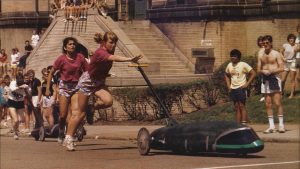
- CIA Regains the Crown. The PiKA DQ helped CIA on the Women’s side, but they didn’t really need it. Coming out of Lane 3 in the final heat, Heat 7, against SDC B and Spirit A, CIA had no problem handling the competition, both in the heat and in the rest of the Women’s races. The CIA A Women’s team, with Black Magic, clocked in at 2:45.33, setting the course record and easily taking their 4th Women’s title in 7 years.
- Alumni Races. We don’t have a ton of details about the alumni heats. But what we do know is that PiKA dominated them. PiKA elected to run Bullet for not 1, but 2 of their alumni teams. And those 2 teams finished 1st and 2nd in the alumni division. The fastest of the times was a 2:16.27, which would have placed them 7th in the Men’s division.
- Communication Problems. An editorial in the April 23, 1985 Tartan, entitled “Buggy Troubles”, took issue with how Sweepstakes handled the incidents of 1985, which it argued were foreseeable. The editorial felt that most of the issues were the results of poor communication and organization by Sweepstakes. The problems, according to the editorial, were from the fact that many people didn’t know what was going on during Raceday and that information was not being disseminated properly. There seemed to be a breakdown in communication between WRCT, Radio Club, and Sweepstakes causing some issues. One example came when Radio Club found out there was a car on the course 2 minutes before a scheduled heat but Sweepstakes was apparently unaware; the Radio Club member stopped the race as the countdown reached 15 seconds, but the editorial argues that Sweepstakes should have known about the car immediately and held the heat until the course was clear. The editorial offered a couple of suggestions to alleviate some of the communication problems: (1) the Sweepstakes Chair should designate 2-4 people to act on her behalf in the Chute and the Starting Line when she can’t be there (via walkie-talkie communication), and (2) Sweepstakes should have a designated PA Announcer, rather than relying on WRCT (whose job is to report on the races, not to make official announcements or be the only source of statistics and information). A third and final suggestion ended up being the most useful going forward for fans – a scoreboard mounted at the top of Hill 2 with regularly updated information. And not all of the issues that the editorial raised were about the races – the article claimed that the 1985 Buggy Book was a “useless, overpriced pamphlet which said virtually nothing”, and that instead the Buggy Book should contain the rules, buggy history, tentative list of buggies/teams/drivers, and statistics. Sure enough, the 1986 Buggy Book ended up much longer and included most of these features.
1986
Raceday: Prelims on Friday, April 18 at 9:00am; Finals on Saturday, April 19 at 8:00am
Sweepstakes Committee: Gretchen VonGrossman (Chair); Gino Cosentino (Ass. Chair); John Spanos (Safety); Patty Illig (Design); Shawn Stufft (Buggy Book)
Men’s Results: (1) PiKA A – King Solomon (2:08.67 – COURSE RECORD); (2) Beta A (2:09.16); (3) CIA A (2:10.42); (4) Spirit A (2:12.11); (5) Theta Xi A (2:13.27); (6) PiKA C – Breathless (2:14.09)
Women’s Results: (1) Spirit A – Elan (2:38.94 – COURSE RECORD); (2) PiKA A – Breathless (2:41.19); (3) CIA A (2:41.48)
Design Comp: (1) SigNu – Yama Bachi; (2) Theta Xi – Rapier; (3) PiLam – Legend
Weather: Sunny, 49-62 Degrees on Friday; Sunny, 54-72 Degrees on Saturday
Buggy Book: 1986 Buggy Book Link
Prediction Score: 15/45 Men’s, 0/10 Women’s (Compubookie); 16/34 (Buggy Chair Consensus)
Jerry Lewis may have been the grand marshal of the 1986 Raceday, and course records may have been set, but the real story of 1986 was the dawn of the new safety era, brought about in part because of fire.
- More Teams Means More Finalists. By 1986, we had reached the peak number of buggy teams, as a crazy 53 Men’s teams and 22 Women’s teams signed up (though not all of those that signed up would end up actually racing). Since Sweepstakes no longer ran the Finals as a Championship/Consolation Finals, there was no reason to constrain the Finals to just the top 6 on the Men’s side. So with 53 teams entered, Sweepstakes decided to expand the Finals to a Top 10; the 10 fastest times on Friday would advance to the Finals, which would be run in 5 heats of 2. As best we can tell, the Women’s races were still a 1 day event, but that would be changing soon as well.
- Road Closures Lead to Friction. The Spring semester started off rocky, as Raceday 1986 was put in jeopardy by the most unlikely of foes – the City of Pittsburgh. As they are every year, a permit request was made for the Spring which included permits for Spring rolls, push practices, and Raceday. The Raceday one, however, caused a problem for the whole lot. The Raceday permit requests (for Friday and Saturday) were to use the city streets from 6am-1pm. The City balked at that request for Friday, as they were concerned that Friday’s races would interfere with rush hour traffic. They instead suggested holding the races on Saturday and Sunday, which was infeasible because Carnival ended on Saturday, or beginning the races after 9am on Friday, which was also infeasible because it would be impossible to finish the races by 1pm, given the number of heats needed. While the decision with the City was pending, they withheld all spring permits, resulting in the cancellation of 1 day of rolls and 1 week of push practices. Thankfully, Anne Witchner (Director of Student Activities at the time) came to the rescue. She explained to the Pittsburgh Director of Parks & Recreation that the roads would not be closed for the entire period; rather, they would only be closed for a portion of that time. The permits were eventually granted, but on the condition that the roads must remain open until 8:30am, when the majority of traffic has passed (though students were allowed to begin setting up prior to then). Ironically, the Tartan’s April Fools edition in 1985 (the Natrat) ran an article that Pittsburgh denied Sweepstakes the permits to close the roads, making it almost the first time that the Natrat had printed a true story.
- Practice Rolls Add Days. By 1986, practice rolls were held on both Saturdays and Sundays! Prior to 1984, practices only occurred on Sundays, so it’s nice to see the expansion here (though we believe Saturdays began in either 1984 or 1985). Fall rolls began on October 26, while Spring rolls began on March 1 and ran through Truck Weekend on April 12-13, with the exceptions of March 23 and March 29 (Spring Break). Though not all of the scheduled days ended up happening; weather cancelled the Sunday, April 13 rolls (as well as others), and another issue prevented more.
- April 5 Rolls Spark Safety Concerns. With just 2 weeks left until Raceday, those involved in Buggy had to be a little concerned with the outcome of the April 5 rolls. In total, the Tartan reports that 10-11 incidents occurred in the single day of rolls. CIA Co-Chair Mark Wilkins commented that CIA had more issues on April 5 than they had in the previous 4 years combined. The worst of the incidents came from DU’s 2-wheeler Horned Screamer, which was unable to make it through the Chute turn cleanly and flipped over, ending up on its side and into the haybales. There were a number of theories for why the troubles came on so suddenly. Some attributed it to the cramped schedule, brought on by the delayed permits and the late Spring Break. That, coupled with inclement weather, forced teams to try and get up to full speed too quickly. Others felt that it was due to experimentation that teams were going through to gain an edge for Raceday. And some thought that it was just a lack of common sense among drivers, mechanics, and teams generally. The good news is that there were no serious injuries, with the worst incident giving the driver a “bump”. But the DU crashes weighed on the organization, and they ended up being scratched from Raceday 1986.
- Safety Changes Are Coming. The issues on April 5 brought about a couple of immediate new safety rules and guidance from Sweepstakes. At the next Chairmen’s meeting, Sweepstakes officially added a rule requiring all drivers to wear helmets. They also reiterated the importance of pass tests, and suggested that drivers conduct course walks not just with their own team, but also with the teams that they will be competing against. Sweepstakes also decided to clarify the rules around re-rolls in races. To improve safety, Sweepstakes explained that on Raceday, if a driver brakes because she feels that she is in immediate danger or something is wrong on the course, she will be entitled to a reroll. One last change that was proposed by Director of Student Activities Anne Witchner was an “Alumni Advisory Board” to act as advisors to Sweepstakes, which would give the students on Sweepstakes a resource that they could trust and turn to regarding safety. Bringing alumni in could also help to close some of the loopholes that currently existed in the safety rules that teams were able to exploit. Some were ok with the idea, as Beta Chair Denzil Boss noted that one of the biggest drawbacks with Sweepstakes being student run is a lack of continuity of command from year to year, and having an alumni advisory board could help that issue. But some students didn’t like this idea, preferring to keep Sweepstakes 100% student run. SigNu Chair Mark Estes stated that having an alumni advisory board is “getting out of hand, that’s a little bit much. Now we’re getting into the field of buggy secrets, and I don’t want to show my buggy to random alumni. If we show it to them, we may as well show it to everybody.” But it turns out that the students feelings on this would become a moot point sooner rather than later. CIA Co-Chair Mark Wilkins summed things up, remarking that another serious accident like 1971 would bring about a reevaluation of Sweepstakes entirely, and that it could mean that “Sweepstakes are over forever.” He just didn’t know how soon that would occur…
- FIRE! Prior to 1986, when people talked about the safety of Buggy, they primarily referred to the on-course safety – the ability of the buggy to make it around the course without injury to the driver or spectators, even in the event of a crash. Even the safety concerns raised by the April 5 rolls, and the changes brought about by those incidents, were about the safety of drivers on the course. But 1986 prompted the safety rules to be broadened beyond just on-course safety, and the changes were the result of the “serious accident” that CIA Co-Chair Mark Wilkins had warned about one week earlier. On Friday, ATO was in their truck prepping their B team buggy, Gander, for its race in the last heat of the day, Prelims Heat 18. ATO’s prep included the chemical heating of the wheels, and the chemical of choice for ATO was Hexane, an oily, flammable liquid. 3 mechanics were inside the truck working on the buggy, and had just loaded the driver into the buggy. According to the April 22, 1986 Tartan, at 12:40pm, some of the hexane being used by ATO leaked from its container and made contact with a radio in the truck. The hexane suddenly burst into flames, filling the truck with smoke and fire. The brothers moved quickly to remove the buggy, with driver inside, from the back of the truck in order to free the driver. As they did this, the three ATO brothers suffered burn injuries. In the interest of privacy, we are not naming the injured students here. The worst injuries were suffered by a then-Junior, who was taken to Mercy Hospital and sustained burns to his legs, face, neck, and right arm, covering 10% of his body. A then-graduate student was taken to West Penn Hospital with a burn on his right arm, and a then-Senior was treated by Paramedics on scene for a burn on his hand. Paramedics arrived within 3 minutes after the fire began, and fire extinguishers from PiKA and Theta Xi were used to put out the fire before the flames, “which were licking at the bottom of the truck”, could reach the gas tank. Thanks to the quick work of those on scene, no further injuries were sustained and the races were able to continue on Saturday, with a new addition of an inspection of all trucks by the Fire Marshall during Saturday’s race. The fire made it so that the alumni advisory board was no longer just a suggestion, and following the end of the semester, a group consisting of Anne Witchner and alumni Tom Wood, Lou Conley, H. Sanford River, Dave Lamont, and Bill Grathwohl got together to complete the 2nd, and most recent, rewrite of the Buggy Rulebook.
- New Buggies of 1986. A number of new buggies were added to the buggy ranks in 1986. PiKA built a new buggy, King Solomon, which would become its A team buggy. SigNu took its carbon fiber strategy a step further by producing Jerboa. According to Mark Estes, Jerboa was an aluminum/carbon fiber hybrid, which resulted in the lightest of SigNu’s frame and shell designs. It had a carbon and nomex pan, with aluminum above deck and a marginally structural shell with glass and carbon. However, SigNu might have pushed things too far, as the buggy had some flex issues. Beta also produced a new buggy, this time naming their buggy Challenger. DU built its second 2-wheeler in a row, named Biakar, though they weren’t able to get it out to the course in time for Raceday. Fringe built multiple buggies, rolling out Barrier and Bargain. Spirit built three (yes, three) buggies, their first builds, racing Elan as their A team, Sting as their B team, and Genesis as their C team. All 3 buggies were space frames and rolled on red derby wheels, with Genesis made out of steel (in true Carnegie fashion) and both Elan and Sting made out of aluminum (in true Hunt fashion). Other builds included ATO’s Squid, CIA’s Stealth, KapSig’s Babble, and SDC’s Banzai.
- Predictions. Compubookie’s predictions on the Men’s side were: (1) Beta A; (2) SigNu A; (3) CIA A; (4) PiKA A; (5) Beta B; and (6) PiKA B. On the Women’s side, he predicted CIA to win (though he said that they should face Fringe, PiKA, and Spirit). We also had a Buggy Chair Consensus, which went (1) SigNu, (2) Beta, (3) PiKA, (4) CIA.
- Spirit’s Impressive Day. It’s one thing for a new organization to be competitive. It’s an entirely different thing for a new organization to win. In just its second year of existence, and first building their own buggies, Spirit had quite the day. On the Men’s side, they made a massive jump, going from second to last (and beating just SAE’s Limo) with a 3:02.26 in 1985 to 4th place (and a trophy) with a 2:12.11 in 1986. But the women’s team was even more impressive, as they came out and set the course record with a 2:38.94 time in 1986, earning their first (but not last) 1st Place trophy. Of course, it wasn’t a perfect day – Spirit Men’s B team had a time that would have earned them the 6th and final spot in the Finals, but their new buggy Sting failed Drops and was DQ’d.
- Men’s Finals and More Records. Spirit wasn’t the only organization having a good day. PiKA had one as well. PiKA A barely edged out Beta A for the top time during Prelims, but they decided they didn’t want to make it that close in the Finals. So one heat after Beta A put up a 2:09.16 time that was just barely off the course record, PiKA A one-upped them. With the new buggy, King Solomon, PiKA A put together the best roll in Sweepstakes history to that point, breaking the course record with a 2:08.67, the first team to ever break the 2:09 mark. Meanwhile, we don’t have the Tartan’s recap of the races, so all we have are the times from the BAA database. So we don’t know the total number of incidents on Raceday (though it seems likely that it was fewer than people had initially feared). The one we do know is that SigNu A’s Colugo advanced to the Finals with the 4th fastest time in Prelims, but never got a chance to claim a trophy because they spun out in the finals, earning a DNF.
- Confessions of a Buggy Chair. Nearly 35 years after Raceday 1986, Mark Estes, then-SigNu Buggy Chair, has a confession to make about the 1986 SigNu women’s teams, provided in the comments below but re-published here (lightly edited). “Confession. I ran the same buggy in 2 different Women’s heats. SigNu ran 2 “serious” Women’s teams in 1986 – one for TriDelt, and one for the SigNu Little Sisters. Combined, they might have taken a Top 3 spot, as there were better than average pushers on both squads. But the two teams could not agree. So instead, SigNu was left with 2 mediocre squads. Something unfortunate happened in the truck before the Women’s races, leading to SigNu being short one buggy. Therefore, Mark decided to send out the same buggy for each team. They were really not that similar (Colugo vs. Lemur), but no one outside of SigNu seemed to notice – despite each of the SigNu Women’s teams winning their heats. I thought I had gotten away with it until the Push Captain for the TriDelt team stormed the SigNu truck and started ripping Mark a new one, at high volume, for “screwing them”. Despite a foggy brain from too much buggy and not enough sleep, I managed diplomacy long enough to explain that the only person screwing them was the one yelling and alerting others as to the swap. That explanation created instant peace, and SigNu avoided getting DQ’d. (Editor’s Note: We’re pretty sure that the statute of limitations has run out on this DQ).
- Hey, Lady. 1986 brought a special guest to the races. Comedian Jerry Lewis was named the Grand Marshal of Buggy, and opened up Raceday 1986.
- A D1 Sport. A satirical article in the March 4, 1986 Tartan argued that Buggy should be made an NCAA Division I sport. The authors suggested that CMU would host the tournament. This would have the benefit of (a) making CMU more well known, and (b) we’d keep winning! Although this was a joke (and probably not worth me repeating here), I decided to include it because I 100% agree with this take and we should turn Buggy into an intercollegiate event.
- 1984 Photos. Below are some photos from 1984.

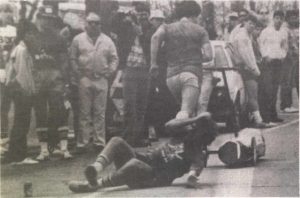
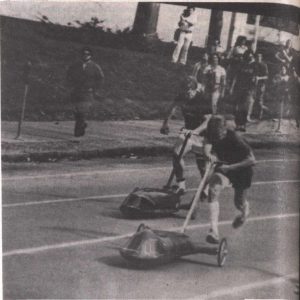
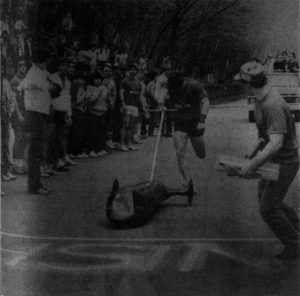
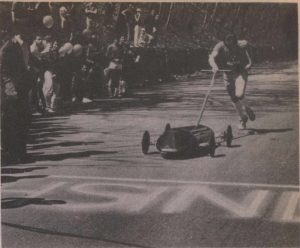








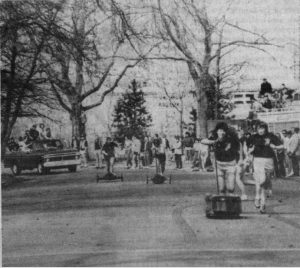
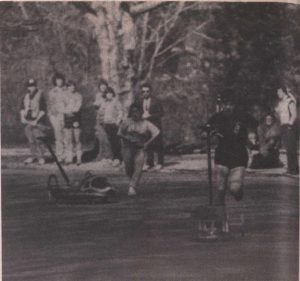
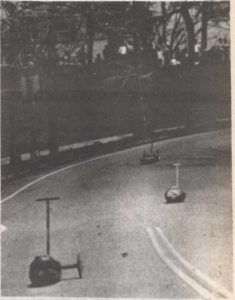
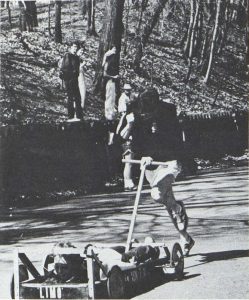
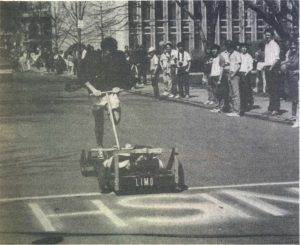

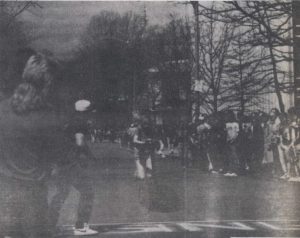


- 1985 Photos. Below are photos that we have from 1985
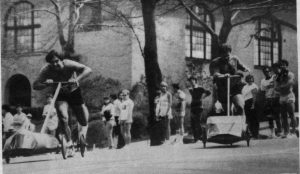
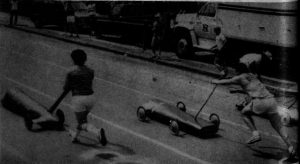
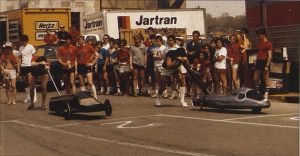
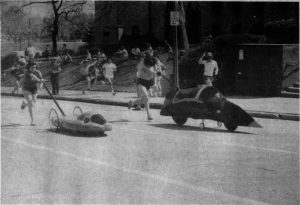
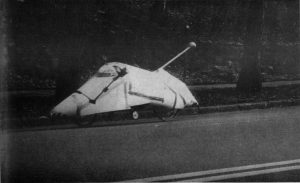
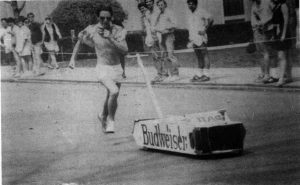

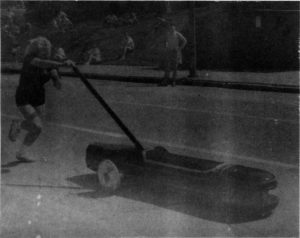
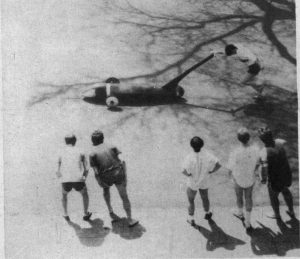


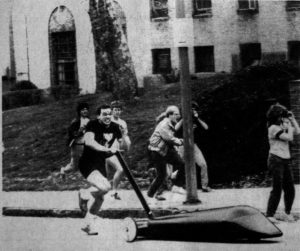
- 1986 Photos. Below are some photos from 1986:
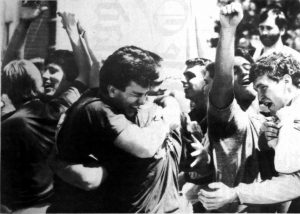
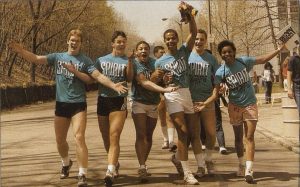

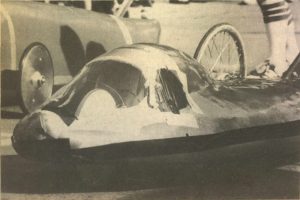
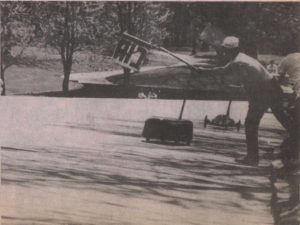
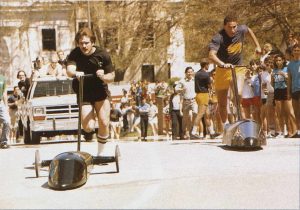
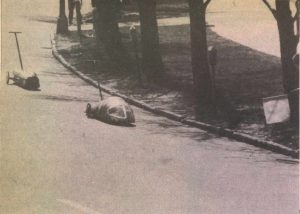
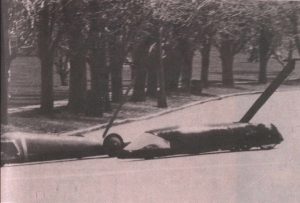
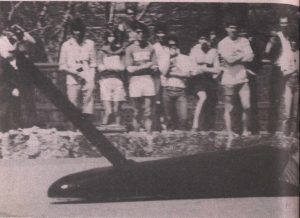
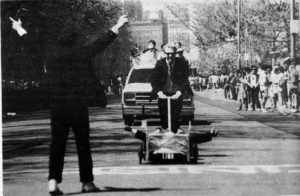


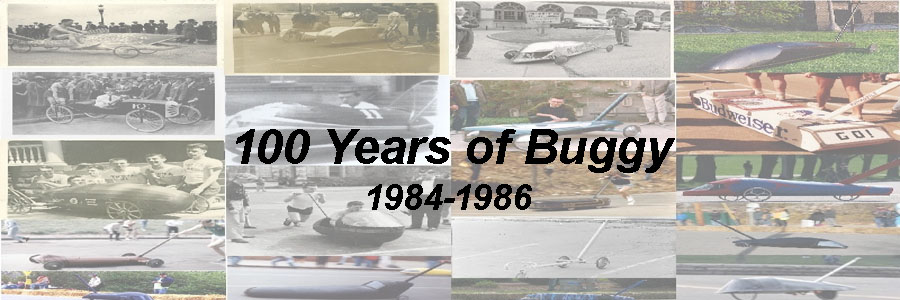
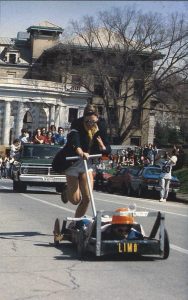
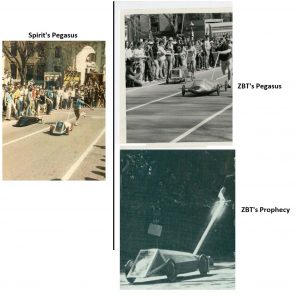

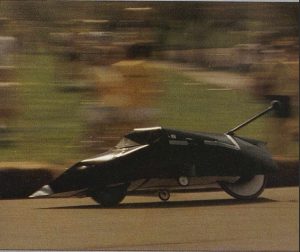

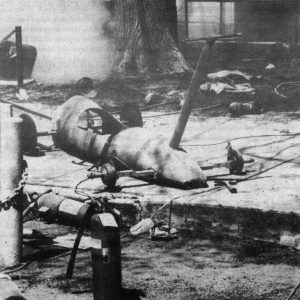

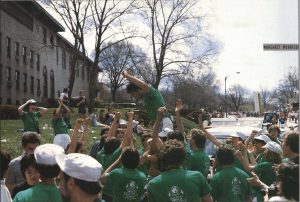

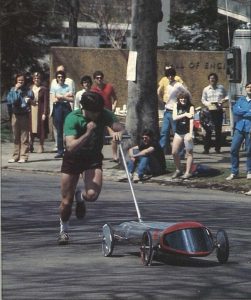



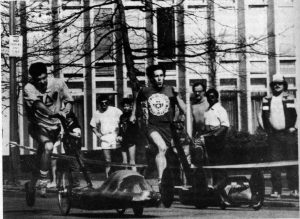
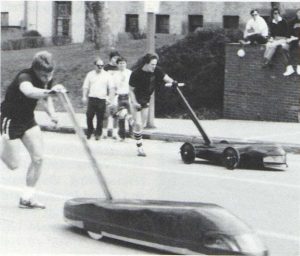
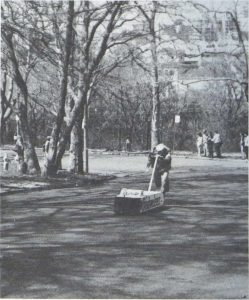
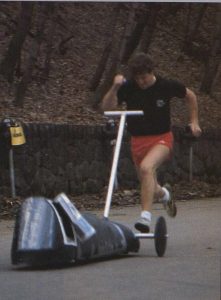



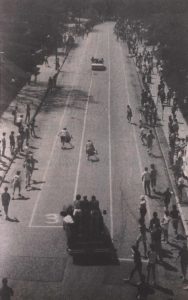

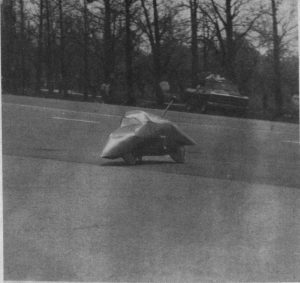


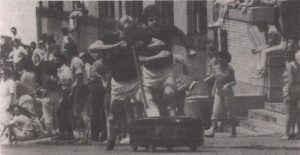
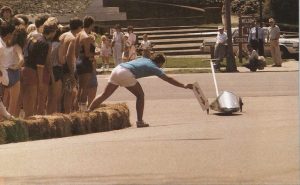
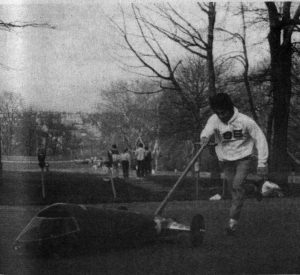

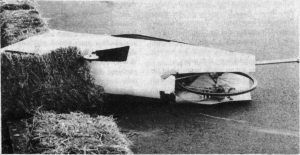

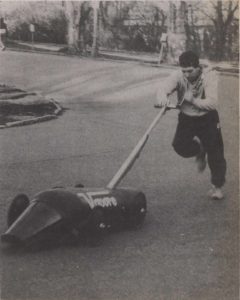

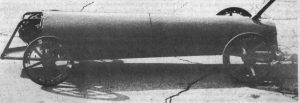
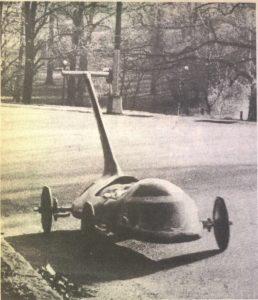
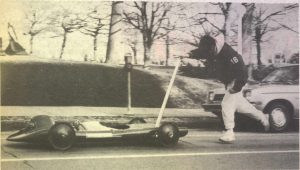
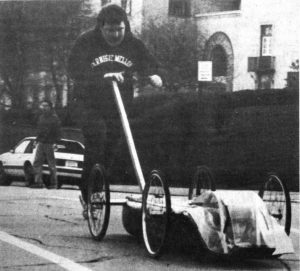
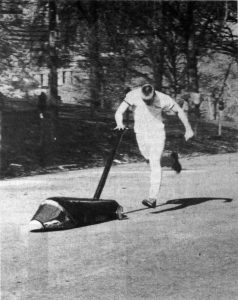

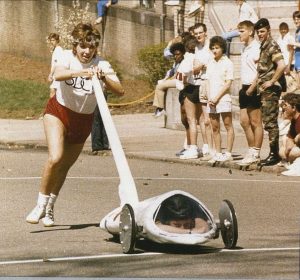


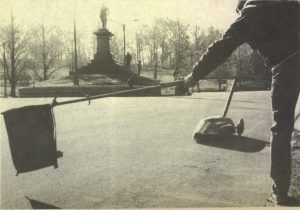



Matthew Wagner says:
Some comments on the 1984-1986 buggy history edition:
“The Spirit pushers weren’t top-end pushers, and Pegasus itself wasn’t a top tier buggy, so Spirit’s final time barely beat SAE’s Limo (and lost to PiLam’s Miss Budweiser).” Actually our pushers were pretty good. But we had never freerolled before with race wheels before, so neber had raced at speed. The hatch ended up popping up earlier on in the freeroll and acted as a air brake most of the way down. The buggy crawled. We fixed it for our women by duct taping the hatch on. They got 7th.
“Spirit also built multiple buggies, their first builds, racing both Genesis and Elon (Sting is also credited as a 1986 buggy, though we don’t have any information about it racing until 1987).” The buggy was named Elan. Sting did race in 1986. Was our B team. Would have placed 6th first day except we failed the drop test. All three buggies were space frames (Genesis steel, the other 2 aluminum) and ran on red derbies.
“But the women’s team was even more impressive, as they didn’t even have a team in 1985, but came out and set the course record with a 2:38.94 time in 1986, earning their first (but not last) 1st Place trophy.” Agree that they were more impressive Spirit Buggy was built on our women’s team. But they did roll in 1985.
“1986 – An unidentified driver prepares for a practice roll (from the 1986 Thistle)” This is Nancy St. Louis in Genesis.
Bryan Arsham says:
Thanks Matt! All of this has been updated/added to the post.
And to those reading, please continue to add your additions/corrections. It turns out, a lot of the time the record is incomplete (or even worse, inaccurate) and only those of you who were actually there will know for sure what happened. And these posts continue to be updated – Within the past week, we’ve made additional changes to the posts from 1980-1983, 1977-1979, and 1940-1945. Our goal is to make this as complete a record as possible, and the worst thing would be to get details wrong (from doing the research, I can’t even begin to tell you how frustrating it is to get conflicting information from different sources, or to see things treated as historical fact that you know to be wrong) or to miss out on some amazing stories that you all have. So keep them coming!
the Pope says:
Comments on 84.
PKA’s A team driver advantage in Audrey was not so much her tiny size as it was her minute weight. I think well under 70 lbs. She really was tiny.
Colugo, when new, was quick but rather unstable due to a short wheel base. That buggy was late in development mostly due to starting out as a 2 wheeled design. 2 2 inch derby sized wheels and a pair or training wheels in the back to be exact. It was a rather unstable 2-wheeled design (confession: I was one of the designers and concepts like rake and tail were lacking in the design). So, that layout never made it past some early roll-around tests in the PA zoo parking lot. The 2 wheeled design resulted in the structural part of the buggy being a bit short of what would make an ideal trike wheelbase. That structure dictated the short wheelbase. The initial ride height was also very high to allow the bike to lean. So, as a trike she initially had ground clearance that was absurd. We did one weekend of rolls like that before she was lowered to a more buggy like height with a symmetric rear axle and hydraulic disk breaks borrowed from scorpion. We rolled like that for another weekend or 2 like that before a non symmetric rear end was applied and an entirely new braking system installed. The next week it was back to a symmetric real axle, not clear why. I recall all of these changes a rather constant stream of new parts and fading grades. I do not believe the body work was completed until after truck weekend. I can recall Colugo rolling within a second of a rather quick Lemur despite sporting a cardboard rear shell on truck weekend. We never really gave the driver, Jane Oliver, a chance to get used to the buggy since it was never the same 2 weekends in a row. The buggy with a full shell was not tested prior to raceday.
Yep, ends up aero matters and a fully clothed colugo was very quick when riding on well managed Goodyear rubber. I believe PKA had the re-roll as one of the quickest rolls on record at the time. That she would do this as a B team is not that shocking. Alan Pollard (ME-85), the hill 2, was very strong and quick and had a very motivated hill 2. Would have likely pushed A team in any other year but we were stacked with fast pushers back then.
How did we manage to get a re-roll for a simple spin? Well, the issue was that the safety chair’s introduced a helmet for the driver on the AM of race day. This new helmet was specific to Colugo only which was odd but given the development above, one can understand that the safety of the driver of a very fast buggy was not a bad place to focus. If you had one helmet, what would you do with it? Anyway,good intent, bad execution. This was before the helmet rules we currently have were in place. During the prelims, the helmet slipped and blocked her vision. Despite this, she tried to make the turn and never touched the brakes. The fun ended at the chute. In the re-roll, moving even faster, she was very late in turning and had no hope of correcting it prior to meeting the outer hay. That impact was impressive and wracked the frame significantly. Drive walked away. Many in the house believed the buggy was toast. A few of us, spent a few days doing unspeakable evil upon the frame to resurrect it. Despite going on to win in 85, It was never really regained the speed it showed in 84. Yet It did manage to hold onto the lack of stability.
the Pope says:
Comments on 85
Heading home from the prelims, the SN men’s A team had posted an unofficial time of 2:08.85. Had this held, it would have been a course record, just nipping the 2:09.0 that was the result of the odd timing from 1983. The video timing system, reviewed later that day, changed the SN time to a 2:09.05 and thus no record was broken. Yes, it did suck. All the more so to have a super accurate timing system used to preserve a dubious record taken with apparent precision to the nearest second.
In the finals, the zoo rolled last, after PKA’s push bar fiasco and dnf’ed . The race was down to Zoo A vs Beta A with much resting on who could get up and over first. It was Dave “Doctor Facely” Bechtel for the Zoo vs. Golden Richards from Beta. That was top fuel drag race with Doc taking it in the end with a sub 15 second hill 1. Going into the roll ahead of Beta, Colugo never looked back. Rob Katz pushing on hill 5 ran a conservative hill knowing that the buggy to beat was behind him by a good margin. Had PKA gotten a late re-roll, it would have been very controversial indeed.
the Pope says:
notes on 86:
We spun. A lot. Much spinning. Almost every SN buggy spinning. One might have thought, ” wow, how could you do worse” I said: “hold my beer”…(87 sucked even more).
the Pope says:
More on 86. Confession. I ran the same buggy in 2 different women’s heats. We ran 2 “serious” womans teams in 86, one for the tri delts, one for our little sisters. Combined they might have giaken a top 3 spot as there were better than average pushers on both squads. They could not agree. So, 2 mediocre squads. Something unfortunate happened in the truck leading me being short a buggy and sending the same buggy for each team. They were really not that similar (colugo vs. lemur) but no one outside of the zoo seemed to notice despite each of the squads winning their heats. I thought i had gotten away with it until the push captain for the tri delts stormed our truck and started ripping me a new one, at high volume, for “screwing them”. Despite a foggy brain from too much buggy, not enough sleep, I managed diplomacy long enough to explain that the only person screwing them was the one yelling and alerting others as to the swap. Instant peace and no dqs.
Shafeeq says:
In “1984 – An unknown heat with a CIA buggy (from the 1985 Thistle)”, the buggy is Spectre.
In “1985 – CIA A’s Women’s team pushing Black Magic up the front hills (from the 1985 Carnival Special Tartan)”, are you sure that’s the right heat? I’ve no idea what that buggy is but it’s got the wrong number of wheels to be Magic. Might be Spectre with yet another shell.
Bryan Arsham says:
Thanks Shafeeq. I am NOT sure that 1985 was the correct heat; I may have mistakenly assumed that The Tartan’s caption of CIA Women’s A’s winning time for that photo meant that the photo was, in fact, CIA Women’s A. But you’re right – it’s definitely not Black Magic. I’ve updated the captions accordingly.
Mark Estes says:
84 Flipper: that nickname was applied to a PKT reverse trike buggy that had a very narrow track (i.e. distance between left and right front wheels). This buggy tended to lift the inner wheel and sometimes flip over due to cornering forces in the chute. I believe they pushed the limit by just a bit vs what would have worked. Their other new buggy, also a reverse trike, had a much wider track and fewer stability issues. They, like many CIA buggies before them, both featured the wheels fully enclosed within the shell. This concept lives on today on fringe and SN buggies, made easier with the smaller wheels of modern times. Flipper was remarkable in how small they managed to get the frontal area despite stuffing a pair of 12 inch wheels in there.
the cook says:
I was in the right place to see two of the above items. The 1985 PiKA A crash had nothing to do with being fouled, just a sudden near 90 degree turn into the curb. Whether braking or steering malfunction I do not know. Also regarding the 1984 Colugo B roll, a police radar unit on tripod was in the chute. It consistently showed 35 mph for top teams, while for the Colugo roll it registered 37 and briefly displayed 38. The wheels were on par with ZooA, the hill 2 as Mark mentioned pushed 2A the following year to 2:09, and the driver was not our lightest by a long shot.